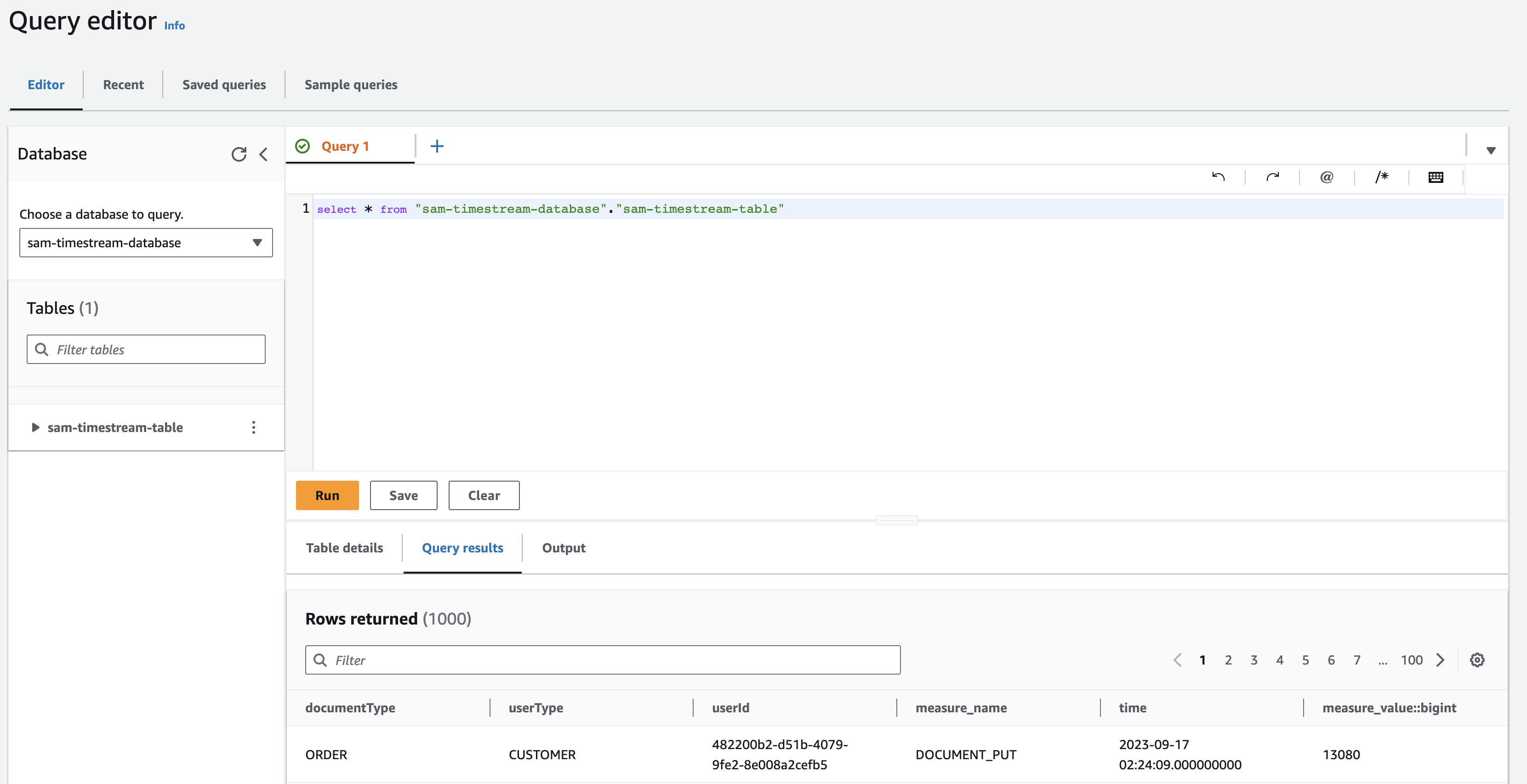When analyzing large datasets over time, using a time-series database such as InfluxDB or TimeScaleDB is essential. AWS offers a managed service called TimeStream available in the following regions :
- us-gov-west-1
- ap-northeast-1
- ap-southeast-2
- eu-central-1
- eu-west-1
- us-east-1
- us-east-2
- us-west-2
In this article, we will cover how to:
- Deploy Timestream in serverless mode
- Populate a table with stream records
- Query the data with a simple SQL query
Project Creation
Comprehensive information about project creation can be found here in a dedicated post.
You now have a template.yml file in the sam-project folder, which we will edit.
Project Deployment
Open the template.yml file and add the following lines:
1AWSTemplateFormatVersion: 2010-09-09 2Description: >- 3 Create Timestream stack 4 5Transform: 6- AWS::Serverless-2016-10-31 7 8Conditions: 9 isDev: !Equals [ !Ref Stage, 'dev' ] 10 11Parameters: 12 Stage: 13 Type: String 14 Description: Stage of this environment 15 Default: "dev" 16 17Resources: 18 TimeStreamDatabase: 19 Type: AWS::Timestream::Database 20 Properties: 21 DatabaseName: timestream-database 22 23 S3Bucket: 24 Type: AWS::S3::Bucket 25 DeletionPolicy: Delete 26 Properties: 27 BucketName: s3-timestream-magnetic-store-rejected-data 28 29 TimeStreamTable: 30 Type: AWS::Timestream::Table 31 Properties: 32 DatabaseName: timestream-database 33 TableName: timestream-table 34 MagneticStoreWriteProperties: 35 EnableMagneticStoreWrites: true 36 MagneticStoreRejectedDataLocation: 37 S3Configuration: 38 BucketName: s3-timestream-magnetic-store-rejected-data 39 EncryptionOption: SSE_S3 40 RetentionProperties: 41 MagneticStoreRetentionPeriodInDays: !If [ isDev, '365', '730' ] 42 MemoryStoreRetentionPeriodInHours: !If [ isDev, '364', '72' ] 43 Schema: 44 CompositePartitionKey: 45 - EnforcementInRecord: REQUIRED 46 Name: userId 47 Type: DIMENSION 48 DependsOn: 49 - S3Bucket
With the following command, you will deploy three AWS resources:
IAM
Ensure yours credentials and IAM permissions include the following policies :
1{ 2 "Sid": "TimestreamPolicy", 3 "Effect": "Allow", 4 "Action": [ 5 "timestream:*" 6 ], 7 "Resource": [ 8 "*" 9 ] 10}, 11{ 12 "Sid": "S3", 13 "Effect": "Allow", 14 "Action": [ 15 "s3:*" 16 ], 17 "Resource": [ 18 "arn:aws:s3:::*" 19 ] 20}
WARNING : These policies is not a best practice and should be adjusted according to your security requirements.
Deploy
Deploy the project with the following commands:
1sam build 2sam deploy --stack-name timestream-stack
Populate table
Prerequisites:
- Install the csv-parser library
- Install the @tsx for typescript execution locally
- Install the @aws-sdk timestream library
1cd hello-world 2npm i csv-parse -D 3npm i tsx -D 4npm install @aws-sdk/client-timestream-query -D 5npm install @aws-sdk/client-timestream-write -D
Now, create the data structure TimeStreamRecord according to your needs, For this example, we will use:
Three dimensions:
1- userId 2- userType 3- documentType
One value:
1- size (document file size)
Two measure names:
1- DOCUMENT_PUT 2- DOCUMENT_GET
1export type TimeStreamRecord = { 2 userId: string; 3 userType: string; 4 documentType: string; 5 size: number; 6 time: number; 7 measureName: TimeStreamMeasureName; 8}; 9 10export enum TimeStreamMeasureName { 11 DOCUMENT_PUT = 'DOCUMENT_PUT', 12 DOCUMENT_GET = 'DOCUMENT_GET', 13} 14
You can build sample data with mockaroo to obtain this sample file:
File: sample.csv
1userId,userType,documentType,size,time,measureName 2a37e3311-3c49-46ae-bdff-7cf877968b45,CUSTOMER,INVOICE,83388,1710348922000,DOCUMENT_GET 3d2c76e6e-9232-41dc-820a-4762924821a2,CUSTOMER,QUOTATION,69918,1709040240000,DOCUMENT_GET 4bda1f773-3c4b-4433-83ab-84f00c1506f2,SUPPLIER,QUOTATION,93095,1720069220000,DOCUMENT_PUT 5...
Finally, run the script populate.ts:
1npx tsx populate.ts 2... 3Result 1001 4Ingested 1000 TimeStreamRecord
You have now populated your Timestream table with records and can view the data in the AWS Console using the Timestream Query Editor.

Request table
For this tutorial, we will execute a simple aggregate query:
1SELECT YEAR(time), SUM(measure_value::bigint), count(*), documentType 2FROM "sam-timestream-database"."sam-timestream-table" 3WHERE 4 time between '2023-07-01' and current_date + 1d 5 GROUP BY YEAR(time), documentType 6ORDER BY YEAR(time)
Script execution of query.ts:
1npx tsx query.ts
Aggregate results:
1[ 2 { 3 documentType: 'ORDER', 4 year: '2023', 5 size: '6575787', 6 count: '134', 7 }, 8 { 9 documentType: 'INVOICE', 10 year: '2023', 11 size: '6710194', 12 count: '145', 13 }, 14 { 15 documentType: 'QUOTATION', 16 year: '2023', 17 size: '7439707', 18 count: '146', 19 }, 20 { 21 documentType: 'QUOTATION', 22 year: '2024', 23 size: '9630998', 24 count: '194', 25 }, 26 { 27 documentType: 'ORDER', 28 year: '2024', 29 size: '10037785', 30 count: '196', 31 }, 32 { 33 documentType: 'INVOICE', 34 year: '2024', 35 size: '9329493', 36 count: '185', 37 }, 38]
Summary
In this post, we learn how to deploy and manage an AWS Timestream database in a serverless environment using AWS SAM, populate the database with sample data, and perform basic SQL queries to analyze the stored time-series data.
I invite you to explore the following aspects of Timestream not covered in this tutorial:
- RetentionProperties (Memory and Magnetic)
- CompositePartitionKey
- Dimension
- MagneticStoreRejectedDataLocation
- Prometheus query & Grafana
- Complexe query (interpolation & functions)
WARNING: Remember to clean up AWS resources
1sam delete


